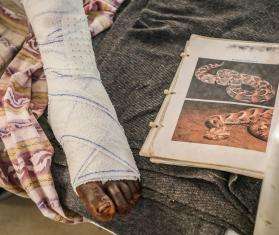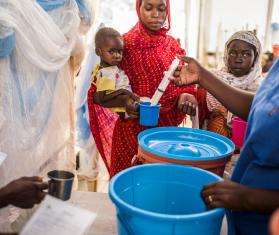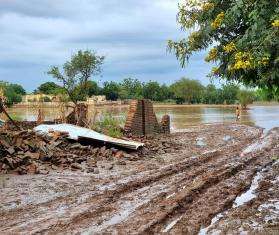Doctors Without Borders/Médecins Sans Frontières (MSF) is working in countries like Zimbabwe, Mali, Honduras, and Malawi to support vaccination against the human papilloma virus (HPV), which causes cervical cancer, and to screen for cancer, two of the most effective measures to fight the disease.
Have you been vaccinated against the human papillomavirus (HPV)? Do you go for regular cancer screenings? Most women in [high-income] countries will answer “yes” to these questions.
If you or your relatives are diagnosed with cervical cancer in Germany, where I am from, your chances of recovery and survival are good. Of the 4,400 people diagnosed with this type of cancer here every year, 90 percent are still alive after five years.
The situation is very different in Malawi, however, where I spent nine months on assignment as a cancer specialist. Here, too, more than 4,000 people are diagnosed with cervical cancer every year. But [in Malawi], almost 3,000 people die every year. This means that Malawi has the second-highest mortality rate for cervical cancer in the world, after Eswatini.
As a gynecologist specializing in oncology, I have mainly treated patients with other types of gynecological cancer over the past five years, as cervical cancer is rather rare in Germany and is usually detected at a very early stage. My daily work in Malawi was a great mental challenge due to this difference.

Treating cervical cancer while pregnant
I was particularly touched by the story of one patient, let's call her Zola. Zola came to us 17 weeks pregnant, and with cervical cancer. Not an easy situation, because in such a case you can't operate without terminating the pregnancy. Zola then decided to continue the pregnancy and undergo chemotherapy, despite possible side effects for the child. Without any therapy, the carcinoma would have continued to grow during the pregnancy and would have worsened her prognosis.
She received chemotherapy every three weeks until shortly before the due date and the child was delivered by planned cesarean section. At the same time, the uterus, its suspensory structures, fallopian tubes, and pelvic lymph nodes were completely removed. Although this is the standard procedure for cervical carcinoma, it is a very extensive operation with many potential risks and requires a high level of technical expertise. My two Malawian colleagues perform this operation up to eight times a week in the project, which is an enormous workload.
I was very pleased that everything went according to plan—fortunately, Zola did not go into premature labor so the operation could be carried out. After two days in the neonatal ward, the baby was able to return to its mother. It was very nice that this patient was not only able to go home cured, but also with a healthy child after all the hardships.
Hurdles to cervical cancer care in Malawi
1. Poor vaccination rate: HPV triggers more than 95 percent of all cases of cervical cancer. Only between 12 and 14 percent of girls in Malawi are fully vaccinated. This is due to both the lack of availability of the vaccine and the challenges of reaching poorer population groups.
2. Hardly any screening: There is a lack of appropriate early diagnosis options, as there is hardly any screening in the public health care system in Malawi and many patients only have very limited access to good quality health care services. In some cases, women were treated incorrectly for months before they came to us.
3. Hardly any early symptoms: The early stages of cervical cancer do not usually cause any symptoms such as pain. Even irregular bleeding is not always [a sign of] cancer, which means that it is not always investigated. A lack of education and also shame in relation to sexual health mean that many patients only come to us very late.
4. Insufficient treatment options: Until the beginning of this year, it was not possible to offer radiochemotherapy (a combination of radiotherapy and chemotherapy for inoperable findings) in Malawi. Only a small proportion of patients were sent to Kenya for this potentially lifesaving treatment.
5. HIV is a huge risk factor: People living with HIV are six times more likely to develop cervical cancer due to their compromised immune systems, and Malawi has one of the highest HIV rates in the world.
60 percent of patients incurable
MSF has treated more than 4,750 patients with cervical cancer in Blantyre since the project opened its doors in 2018. The city lies 3,280 feet above sea level, surrounded by mountains. Although 800,000 people live there, it often felt like we were in the countryside. There were lots of trees on our site and birdsong could be heard all day long; the air was fresh and clear. I could walk the 10 minutes to the hospital every morning.
Most of our patients came for consultations at a very advanced stage. I mainly treated women who came for an examination because of suspected cervical carcinomas or, in rare cases, vulvar or ovarian carcinomas (ovarian cancer). Their screening results had already been conspicuous in previous examinations. We were effectively the second step in the diagnostic procedure. We took samples and used ultrasound to determine the stage of the tumor. We then found out whether the cancer was still operable, whether the patients needed chemotherapy or whether a cure was no longer possible. In 60 percent of the patients we examined, unfortunately only palliative treatment was available and no cure was possible—that was extremely depressing.
Enjoying my work—despite all the difficulties
Time and again, I had to give very young women, some of them single mothers, very poor diagnoses and prognoses. That wasn't always easy to bear. I tried to maintain a certain distance, which was helped by the fact that I always worked in a team and usually had a Malawian nurse at my side to translate. This meant that I was able to initiate individualized therapy from a medical perspective without being completely overwhelmed by the difficult fates.
Despite all the difficulties, I really enjoyed working in a very close-knit team. I was responsible for a lot of things myself, but we were still in constant communication—whether at the weekly tumor conference, where we discussed the patients' treatment plans, or in discussions with colleagues from the palliative and psychosocial teams. The mutual support and good atmosphere made a big difference.
The problem lies in the system
The reasons for the dramatic situation in Malawi are complex. The country, located in southeast Africa, is considered poor: According to the World Bank, more than 70 percent of the population live below the poverty line. Accordingly, the health care system is inadequate and has enormous gaps in provision.
All of this has serious consequences. On a normal day, I saw around 15 patients—of whom a good 12 had carcinoma. The severity and density of the cases that I experienced in Malawi in just a few months was completely unfamiliar to me from my previous 10 years of work in Germany.

How MSF treats cervical cancer without radiation therapy in Malawi
Read moreDepending on age and stage, treatment options were considered after examination and diagnosis. For the older patients aged between 65 and 80, the main focus was on good palliative care. We tried to minimize their pain during their remaining time.
It was different with the younger patients. I was always very relieved when a patient came to us at a stage that was still operable. If the operation could then be performed successfully and the pathology results confirmed our previous assessment, no follow-up treatment was necessary. The patient was discharged with a good prognosis.




